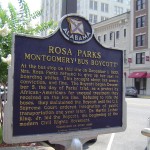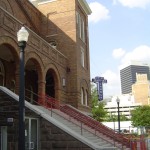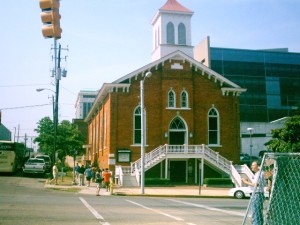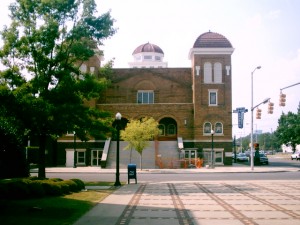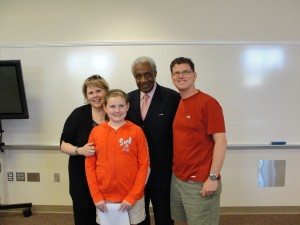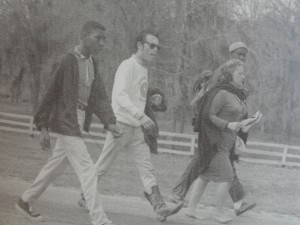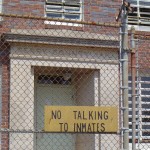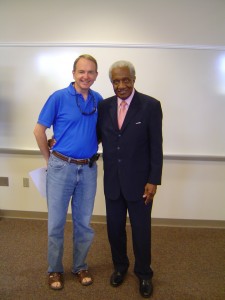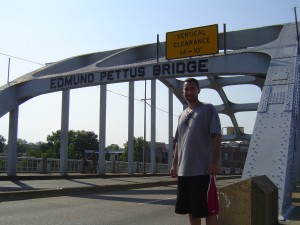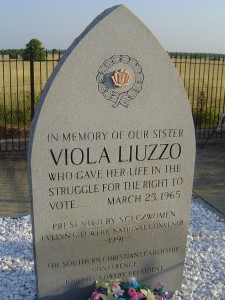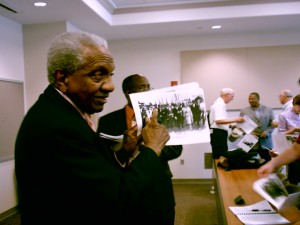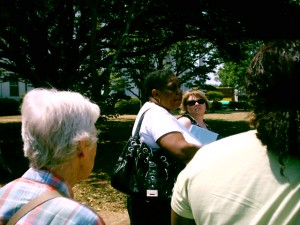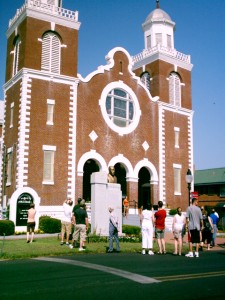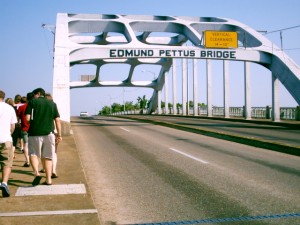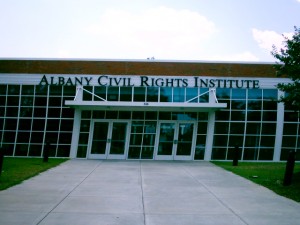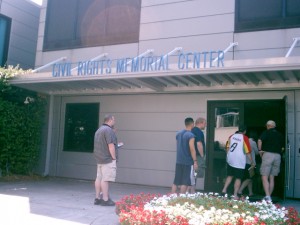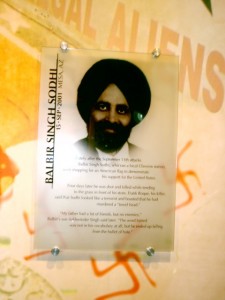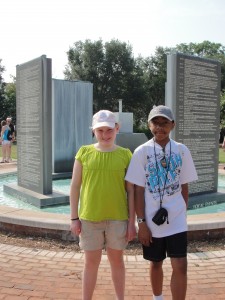Good Morning from Birmingham, Alabama! Yesterday was yet another day of moving, inspiring and heart-breaking discovery in Montgomery and Birmingham. We have visited many important sites along the trail of the Civil Rights Movement in this journey, and each one has so many significant stories to tell. I continue to be captivated by the unyielding faith of the people involved in the movement, and in particular I am challenged to consider the significant role of The Church in the movement. There were few safe places to gather for African-Americans and white advocates in the movement, and in some instances it was made illegal for more than three African-Americans to gather together. Therefore, the churches became the meeting places for organizing, planning, fellowship and mutual encouragement. Mass meetings were an extremely important part of the movement and at these mass meetings there where life-giving sermons and courageous singing, including songs like “We Shall Overcome”, “Ain’t Gonna Let Nobody Turn Me Around”, and “This Little Light of Mine”.
The churches in the movement were extremely courageous and brave to open their doors to this fight for freedom and justice. While they became safe havens in some ways, they also became targets for hatred and violence. Bombings were a normal occurrence in the movement. Yesterday we visited Sixteenth Street Baptist Church in Birmingham, where members of the KKK ignited a bomb on September 15, 1963 taking the lives of 4 young girls, Denise McNair, Cynthia Wesley, Carole Robertson and Addie Mae Collins. If you have the opportunity, please see Spike Lee’s film “Four Little Girls” that tells the story of these four girls and their families.
This journey we are on has challenged me to think about so many things, and the role of the church is at the forefront. The church was a “home base” for the movement and hosted countless mass meetings to strengthen and encourage members of the community. The risk was great, but the outcome was extraordinary. I am challenged to consider our present-day churches. Are we advocating for the rights of God’s children? Are we safe havens for people fighting for freedom and justice? How are we transforming the world around us? 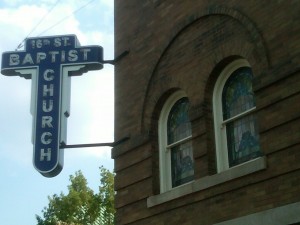

Archive for June, 2011
The role of the Church in the movement
Thursday, June 16th, 2011Do you know?
Thursday, June 16th, 2011ALABAMA – Montgomery and Birmingham
Today we visited the Rosa Parks Museum in Montgomery, AL and had some great photo opps at Civil Rights sites around Montgomery. We then went to Birmingham where we visited the Birmingham Civil Rights Museum (www.beri.org).
Do you know that in Birmingham in 1944 there were 42.8 students per African-American teacher and 24.3 students per White teacher?
Do you know that in Birmingham in 1944, African-American teachers made only 60% of the salary that a White teacher made and their class size was much larger (see above)?
Did you know that in 1950, 73% of African-American males worked as laborers and only 33% of White males worked as laborers?
Do you that in the 1960’s nearly 50 unsolved racially directed bombings led to the unofficial name of Birmingham as “Bombingham” instead of “Birmingham?”
Do you know that in Birmingham in 1963, 1,000 children marched from 16th Street Baptist Church protesting segregation and were arrested and jailed?
Do you know that children who were protesting were sprayed with fire hoses, strong enough to take bark off a tree and surely strong enough to take skin off a human body?
Do you know that on September 15, 1963, a bomb was planted by the KKK and exploded near the basement of the 16th Street Baptist Church in Birmingham killing four little African- American girls who were in the church bathroom after Sunday School?
Do you know that their names were: Addie Mae Collins, age 14, Denise McNair, age 11, Carole Robertson, age 14 and Cynthia Wesley, age 14?
Do you know that the deaths of these little girls coupled with the killing of President Kennedy 2 months later caused such an emotional stir that it helped pass the 1964 Civil Rights Act?
Do you know…?
That I went to a shop last evening and started talking with the White store clerk. The subject of our “Returning to the Roots of Civil Rights” journey came up. I asked her if she still saw segregation. She told me that she is from a small town not far from Birmingham and that she started dating an African-American man. She said that when she told this African-American man that she was from that particular town (“Where the African-American people still live in “The Colony”) he asked her if her father was going to kill him if he found out they were dating.
State of the Group Address…
Thursday, June 16th, 2011…well, sort of anyway.
First, a brief summary…
Today, the halfway point of the trip, we started out with a Montgomery home and church blitz of sorts. These stops included the Carr home, the Dexter Parsonage, the Dexter Avenue King Memorial Baptist Church, the Holt Street Baptist Church, and the First Baptist Church where Ralph Abernathy was the pastor and where the First Baptist Church siege took place in response to the Freedom Riders.
From there we proceeded to the Rosa Parks Museum and then on to Birmingham to visit the Birmingham Civil Rights Institute. There was a lot to take in between the two of these stops; the Institute especially contained an abundance of knowledge and fascinating exhibits. Right next door was the Sixteenth Street Baptist Church where Addie Mae Collins, Denise McNair, Carole Robertson, and Cynthia Wesley lost their lives when the church was bombed by a member of the Klan.
Some thoughts and Reflections…
A few years ago I took a racial reconciliation “class” with Winston Seegobin and Evie Telfer. I put the “class” part in quotes because it wasn’t so much a class as it wound up being more of a place for discussion and healing. The emotions in these sessions got fairly raw at some points but also forced the various members of the group to move past the normal questions and observations and onto another level where healing and genuine care and reconciliation began to take place. It is encouraging for me to see similar things happening on this trip amongst the members of our group. Many of the questions and thoughts being posed are not easy and are downright frustrating. But the fact that we are considering and facing things that we never have before on a personal level is where it begins…never easy and often painful, but anything worth going after usually is.
Some of these reflections have involved considering what situation we might be in if we were making this tour during the heat of the Movement, as well as what those of us who were alive remember and experienced during this time period. There are a few different people on the trip who have this experience and it has been thrilling and hard for me to listen to the stories and thoughts that have been related to me. The emotions involved with recalling these experiences are not always pleasant regardless of who tells the story.
For those of us who don’t have the memories, there are a number of scenarios and thoughts. It occurred to me for the first time today that I would not have come into existence due to the fact that even if my half-black father had married my white mother there is no telling what could have happened. It is a virtual guarantee that it would not have gone over well though. Just reinforces the facts that God is good and faithful.
My last thought concerns the mindset of things. Yesterday while at the National Voting Rights Museum & Institute in Selma, I observed an exhibit about churches and their involvement. I was scanning over it preparing to keep moving when the words “Springfield, Massachusetts” caught my eye…my home area. It was in a section talking about churches that had been bombed or torched. I was surprised and disturbed to see that in 2008, just after Barack Obama was elected president, the predominantly African-American church had been torched. The church has since received support and as of the end of April 2011 was nearing completion.
Obviously we know this sort of thing happened during the Movement when these unfortunately were frequent occurrences and the racism and prejudice were blatant. But the common thinking, the comfortable thinking that myself and my fellow tour members are getting away from, is that everything is all better now. We don’t really have those problems; we even have a black president so we can move on to something else. But sadly the mindset of some have not changed as is evidenced by such events as those in Springfield and by many others that we are not even aware of.
And that has brought us to the point where we are now, halfway through our trip with many, if not all, chewing on the question of how do you go about changing the hearts and minds of individuals who are not even aware that our schools and neighborhoods still have work to do?
Montgomery & Birmingham, AL
Thursday, June 16th, 2011We spent half our day in Montgomery, AL visiting the homes of activists and churches that were sites of civil rights activism. These included the home of Johnnie Carr, close friend of Rosa Parks and longtime President of the Montgomery Improvement Association. The Dexter Parsonage, home to Martin Luther King when he was pastor of the Dexter Avenue King Memorial Baptist Church (1954-1960). We also visited the First Baptist Church where Dr. Ralph Abernathy, the civil rights leader and close friend of Martin Luther King Jr. pastored for eight years from 1952-1961. We also visited the Holt Street Baptist Church which was a place from where King, Abernathy, and others mobilized people for the Montgomery Bus Boycott (1955-1956). Needless to say, these visits brought home the central role played by the African-American church, its leaders, and the faith of ordinary citizens in taking the road to non-violent protest in the pursuit of freedom, equality, and justice for themselves.
The second half of the day was spent in Birmingham, AL first at the Civil Rights Institute where we spent some time studying the exhibits. We were treated to a rich display of artifacts, photographs, films, and literature from the period that confirmed what we had seen, heard, and read about the Civil Rights Movement—the painful and long drawn struggle of African-Americans (and other groups) to gain equal rights in the face of institutionalized racism, the complicity of many white churches, and the violence, humiliation, and beatings dished out by police, the KKK, and individual white citizens in Alabama and other southern states. The incidents of violence are too numerous to detail here…but consider this: The Rev. Frank Shuttlesworth was severely beaten by a mob when he showed up to register his children at an all white school!! Shuttlesworth went to jail about 35 times, his house was repeatedly bombed, and he was attacked, insulted, and beaten on other occasions. Undaunted, he continued to pursue civil rights issues…one person I wished I could have met (he is still alive and I believe lives in Ohio). Read about him if you can… Another stunning incident was the case of 13 year old Virgil “Peanut” Ware who was shot by Larry Sims as he was riding his brother’s bicycle. Sims, a 16 year old white boy who was an Eagle Scout and a straight A student. Sims served 6 months in a juvenile center and was then released. Thomas Blanton who was the main accused in the 16th street Baptist Church bombing in 1963 (which resulted in the deaths of 4 innocent children) was convicted of his crime only in 2001, nearly 40 years later!! Many accused simply were let off by the all-white juries of the time. There are numerous instances of such crimes being committed, often with the perpetrators either being set scot free or never being discovered!! What struck me in all this was the power of racism to pervade the lives of ordinary people to the extent that they lost their humanity despite their education and participation in the church! I also realized that had I been in the United States south in these time, I would have had to “keep my place” and stay in line, or at least my side of the racial line…no guesses on what that would have been. I will not try to hide the fact that, this has not always been easy to digest…
Anyway, after this, I went across the street from the Institute to the 16th street Baptist Church, the site of the infamous bombing mentioned above. Earlier, in the bus we had watched a film by Spike Lee called “Four Little Girls,” which covered the bombing of the 16th street Baptist Church in Birmingham which resulted in the deaths of 4 innocent girls– 11-year-old Denise McNair and three 14-year-olds: Cynthia Wesley, Carole Robertson and Addie Mae Collins.


Selma Alabama
Wednesday, June 15th, 2011This journey continues to intensify and at times it is a struggle to adequately express what we are seeing and hearing as we travel through the Deep South. Today we were in Selma and in Marion, Alabama. We saw photos and heard story upon story from actual participants in the Civil Rights Movement .
The folks that shared their stories today made history come alive. The journey through this time in America’s history is horrifying however it also shows the strength of the human spirit grounded in faith. Some of the stories we heard today were that of unadulterated evil committed against African-American’s striving for their Right to Vote. Following is a brief list of words that detail the sheer evilness of this time in our history:
Electric Cattle Prod
Murder
Billy Club
Hate
White Supremacy
Fear
Graves
Tragedy
Inhumane
Segregation
Ambush
Cowards
Madness
Scared
Crazy
Tear gas
Violent
Alabama State Police
Governor Wallace
Corrupt
Death
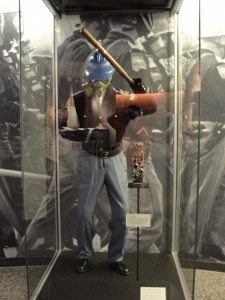
Gear worn by the Alabama State Police when they ambushed the peaceful march of the Edmund Pettus Bridge
Also today we heard stories of hard fought justice and success and of faith and of life. Some words that describe this are:
Registered Voters
Equality
Success
Marching Shoes
Courage
Justice
Prayer
Faith
Young and Old
Black and White
Non-violence
Dr. Martin Luther King Jr.
Rev. Abernathy
Ms. Viola Liuzzo
Ms. Joann Bland
Church
Freedom Songs
Resilience
Strength
Rev. Reese
Human spirit
I am so thankful for the people that shared with us today, for Rev. Reese and for Ms.Joann Bland. This is an education and journey that I will never forget.
“Truth crushed to earth will rise again.”
Wednesday, June 15th, 2011Today was a very full day, in more ways than one…specifically in regards to the intake of knowledge and the intake of multiple soul food buffets! The highlights of the day are as follows:
– Lowndes County Interpretive Center
– Meeting Rev. Frederick Douglass Reese
– Lunch and tour with Mrs. Joanne Bland Perry County Jail
~ Jimmy Lee Jackson Gravesite
~ Tour of Selma, AL
~ Walking across the Edmund Pettus Bridge
– National Voting Rights Museum & Institute
– Viola Liuzzo Memorial
At our first stop, the Lowndes County Interpretive Center, I heard of “Tent Cities” for the first time. Where the center is now located a group of sharecroppers set up tents for the families to live in after they were forced off of the lands of plantation owners for attempting to register to vote. Conditions were not good; whites would take shots at the city on their way by sometimes, and there was one story of a young teenage woman who bled out after giving birth because she had no way of getting sufficient medical attention. All for simply attempting to register to vote.
Our next stop was one of my favorite speakers on the trip thus far: Rev. Frederick Douglass Reese. Rev. Reese was the president of the Dallas County Voters’ League and was a prominent leader on many fronts in the movement in Selma. He was also instrumental in bringing Dr. King to Selma to help with the movement there. His message held a fairly encouraging tone to it, emphasizing that one can never know what kind of an effect they are having on others, and that for this reason they should always be aware of what kind of example they are setting and to make sure that it is the right one.
“Who wants to buy me that house?”
For lunch we stopped at a spot called “Essie’s” where we had some more Southern cooking…namely a very filling and satisfying soul food feast. During this time we met Mrs. Joanne Bland, who runs a program (for lack of a better term) called “Journey’s for the Soul.” You can check the link on the Links page.
She spoke to us of her experiences. How she lost her mother at a young age because she wasn’t permitted to have a needed blood transfusion with “white blood.” How she and her sister were among those attacked on “Bloody Sunday” while trying to march from Selma to Montgomery. To this point our group had not heard much more than the official and documentary accounts of this march, so hearing the details first-hand made it that much more real and painful to hear.
From Essie’s, Mrs. Bland guided us through Marion, AL, where we saw the Perry County Courthouse, jail, and the Zion United Methodist Church. It was here that a mass meeting and a night march took place that cost Jimmie Lee Jackson his life while trying to protect his mother and grandfather from an trooper’s attack. We were able to see his gravestone, which disturbingly is sometimes used for target practice by locals who drive by the site. There were numerous marks and chips from bullets that were visible on the stone.
We then returned to Selma where Mrs. Bland gave us a riding tour of the area. She showed us several locations and along the way pointed out several impressive houses which she offered to let us buy for her. 🙂
The high point of this tour for me was when we exited the bus and walked across the Edmund Pettus Bridge…a simple and exciting exercise for our group but one that cost people dearly on March 7, 1965.
Once we had crossed we thanked Mrs. Bland and said goodbye and entered the National Voting Rights Museum & Institute. While there were a number of excellent displays, the museum was actually undergoing a bit of a transformation. Based on what we saw today it appears as though the finished product is going to be well-worth a visit. It will be exciting to see.
Our last stop came along the highway back to Montgomery: the memorial for Mrs. Viola Liuzzo, a Michigan woman who was so moved by the television reports that she saw of Bloody Sunday that she left for Selma to help with the third march. While there, she was murdered by the Klan while transporting marchers between Selma and Montgomery.
One of the sad things about this story is that Mrs. Liuzzo’s reputation and character were destroyed by rumors from the Klan and the FBI. Her children only found out the truth about their mother in recent years. Additionally, a fence was put up around the memorial because of vandalism problems.
A significant theme that I have noticed during this trip thus far is that there is so much that I have not heard; so many inspiring and yet equally horrifying and frustrating stories that have been buried or overlooked.
-V
I come to say to you this afternoon, however difficult the moment, however frustrating the hour, it will not be long because “truth crushed to earth will rise again”.
– Rev. Dr. Martin Luther King, Jr., “Our God Is Marching On”
from the steps of the State Capitol in Montgomery Alabama on March 25th, 1965
Selma, Alabama and much more
Wednesday, June 15th, 2011Today we visited sites of civil rights protests in Alabama, mostly in Montgomery and Selma.
The first was the Lowndes County Interpretive Center, in White Hall, AL. In 1964, this county was the site of intense racism, inequality, deprivation, intimidation, and violence. While 80% of the county was made up of African Americans, it did not have a single African American registered voter! The interpretive center is administered by the National Park Service.
Immediately thereafter we went to Wallace Community College to meet with Rev. Frederick Reese who was President of the Dallas County Voters League (DCVL) who spoke to us about his experiences organizing voting marches and protests and trying to increase the number of voters in the county (the real increase in numbers came later with the passage of the Civil Rights Act in 1964). Sprightly, articulate and looking a youthful 82 years, he gave an account of the teachers march in Selma, Alabama in 1965. Central to his protest and demand for equality was his Christian faith and he made no excuses for it. He remains convinced that it was his faith that sustained, motivated, and empowered him to act as he did. He figures prominently in surviving videos of the civil rights movement in Selma. We also met James Perkins the first African-American mayor of Selma (2000-2008).
Lunch was at a soulfood buffet on Highway 80 called “Plantation Inn” and provided a rich fare of corn, okra, collared greens, fried & grilled chicken, pork, black beans, broccoli, mashed potatoes, macaroni & cheese topped off with peach cobbler, bread… The story of how this repertoire of culinary meanings and practices that make up soulfood was assembled is a fascinating one, but its retelling will have to await another occasion. But you might recall Jake Diaz’s presentation on this subject at Messiah in February 2011.
At “Plantation” we were introduced to Ms. Joanne Bland, a civil right activist who was 11 years old when she participated in the “Bloody Sunday” march from Salem to Montgomery (7 March 1965). In particular she experienced the brutality of state troopers who rushed the marchers at the, now infamous, Edmund Petters bridge assault. She spoke about her experiences with a caustic wit that was irreverent to the niceties of polite conversation. Her accounts of life in pre-integration Salem revealed the deep unrelenting, daily brutality of segregation in the south. From riding buses, to treatment in offices, the patronizing gaze of the wealthy elites of plantation society, and the terror tactics of the KKK clearly brought the situation to a boil by the early 1960s.
Ms Bland took us through a tour of Selma and we saw the different sections of the city which was by and large integrated (barring the golf course!!). We visited the Zion United Methodist Church (where the protesters commenced their marches), the Perry County jail, the Jimmie Lee Jackson Gravesite (killed during the protests while trying to shield his mother from a state trooper), and the National Voting Rights Museum and Institute (which was under renovation). We also visited the Edmund Petters bridge, mentioned earlier, and it was touching to be at the same spot that had seared the conscience of a nation and the world in 1965.
On the way back to Montgomery we stopped to visit the Viola Liuzzo Memorial (see previous post). This was followed by dinner was at a diner called Dreamz, whose owners were involved in civil rights cases calling for integration of the schools in Montgomery.
Visiting smaller places like Selma gave me a valuable insight into the personal perspectives of participants in the Selma to Montgomery march. In a city of Atlanta, discerning the racial divide required some digging around, whereas in Selma, it seemed to be lying just below the surface. I also realized that the Civil Rights movement has no single narrative. Rather, it is made up multiple narratives that sometime jostle to find expression in the public sphere. Since some of these sites are of national historic value, they fall under the jurisdiction of the state and its agencies which invariably try to insert “an official” voice into the brochures, notice boards, and audio visual presentations. Nowhere did this become so clear as in front of the Zion United Methodist Church in Marion, Alabama. Here a National Park Service information board on the Selma to Montgomery National Historic Trail announced that a the “American people” were the “confluence” of “two fundamental ideals”—“democratic equality and nonviolent protest”! Certain white groups would no doubt have another view of these events and their memorials. For instance, one notice posted by a southern group in Selma’s Town Hall declared a sesquential celebration of the “War for Southern Independence” a.k.a the Civil War. In addition to this the surviving participants of the civil rights movement have their own memories, understandings, rememberings and forgettings that do not always coalesce to create a neat linear narrative. The Civil Rights movement is a diagnostic event that captures the agency of a variety of historical actors—the agency of ordinary people, memory, state and nationalist erasures or incorporations of local events and histories to produce the national character of a people…the list could go on and on…And then there are the painful stories of segregation, too painful to share here…
The racial divides persist here in Alabama and elsewhere…
Songs of Survival, Hope, & Resistance
Tuesday, June 14th, 2011Songs of Survival, Hope, & Resistance
Our journey today started off with a memorable visit the Albany Civil Rights Institute in Albany (GA). On the way we heard songs sung by the Rutha Harris of the Albany Freedom Singers which were inspirational. Music was critical not just to the activists of the civil rights movement; it had always served as a vehicle by which African Americans recorded and remembered their past, their struggles, and hopes for the future. These were songs of survival, hope and resistance. As Rutha Harris, one of the Albany Freedom Singers told us, “The music kept us going, kept us from being afraid.” During the civil rights movement freedom songs raised the social conscience of blacks and were made up of songs from the slave era, spirituals of the black churches of the South. The lyrics of one song ran “Aint gonna let nobody turn me around….I’m gonna keep on walking, keep on talking…marching onto freedom land.”
This music and perhaps many sermons of the time were about freedom, overcoming distress,
A movie on Rosa Parks kept us engaged as we traveled to our next stop—Montgomery Alabama.
Perhaps one of the most memorable things that I read about today was the story of Kay Smith Pedrotti and Gloria Ward. Both stood on opposite sides of the civil rights movement, the former being white and the latter black. Pedrotti supported segregation while Ward championed full integration of African Americans in everyday life. 35 years later, in 1998 Pedrotti and Ward finally met and reconciled with Pedrotti saying that “It took 35 years to find Gloria—and forgiveness of my racist past” (cited on a poster in the Old Zion Baptist Church, Albany, GA).
Later in the day we visited the Southern Poverty Law Center in Montgomery, Alabama. This nonprofit civil rights organization was founded in 1971 by civil rights lawyers Morris Dees and Joseph Levin Jr. The SPLC is internationally known for tracking and exposing the activities of numerous hate groups most famously the United Klans of America in 1981. Its activities resulted in the United Klans of America going bankrupt. Our group also learned about Viola Liuzzo a white married mother of five and civil rights activist who lived in Minnesota. In the early 1960s she saw what was happening in Alabama and left her family and traveled alone to Alabama in her car and helped out in the civil rights movement, joyfully ferrying activists from place to place. Her activities came to a tragic end when she was hunted down by KKK activists and brutally murdered in 1965. I was told that the then FBI Director J. Edgar Hoover planted misinformation on her to question her integrity a perception that many believed in, including her children, and it was only in the last 10 years that they came to learn the truth about their mother. Viola Liuzzo’s story has been portrayed in a documentary called Home of the Brave. What amazed most of us in the group was the continued persistence of racist and hate groups which have apparently proliferated after the election of the current President Barack Obama. The SPLC’s continues to vigorously pursue such groups by taking them to court.
Outside the building is a simple yet powerful memorial to 40 civil rights activists who gave their lives in the pursuit of civil rights agendas. Designed by architect Maya Lin (of Vietnam Memorial fame), the circular black marble base with a fount of water at its center was built in 1989. The water flowing over the names of the activists is inspired by Martin Luther King Jr’s paraphrase of Amos 5:24 “We will not be satisfied until justice rolls down like waters and righteousness like a mighty stream.”
This heavy dose of religious faith, activism, violence, tragedy, and triumph made this third day of our tour a rather heavy one to process. I was particularly moved by the well-known case of Balbir Singh Sodhi, a Sikh from India, who was gunned down in the wake of 911 because his assailant wanted to “kill a Muslim.” Sodhi’s death reminded me of the worry experienced by members of my own family, living in New York, in the wake of 911. Was Sodhi a victim of 911? Apparently, the state of Arizona did not think so and for some time toyed with the idea of removing his name from a memorial for victims of 911. In May 2011 the state backed down in deference to the wishes of the Sodhi family and thousands of individuals who had petitioned on their behalf. That is where the matter rests, for now. More details are available at http://www.saldef.org/news/victory-arizona-governor-vetoes-anti-sodhi-memorial-bill/
Tomorrow will be another day.
Until justice rolls down like waters and righteousness like a mighty stream”
Tuesday, June 14th, 2011Greetings from Montgomery, Alabama! It is hard to believe that this is only the third day of the trip, given all that we have seen and experienced. I am incredibly blessed to have this opportunity and I am being challenged and inspired in such meaningful ways.
My colleagues on the trip have done an excellent job sharing on this blog what we have seen and experienced so far. In some ways trying to take in all of this is like “trying to take a sip of water from a fire hydrant” and anything I would try to say about the experience would not do it the proper justice. But there have been things that I have been consistently reflecting on – one of which is the power of the stories that we are hearing. The resiliency and perseverance of people involved in the Civil Rights Movement is nothing less than inspiring. The dependence on God, the community of believers and activists, and the importance of inspiration from Scripture and music have been highlighted by all of the people involved in the movement. And there is still so much more to learn.
Another thing that I am deeply contemplating is that in all of the stories that I am hearing on this trip, folks that looked like me were the antagonists. There are stories of some white advocates in the movement, but those were exceptions. The severe injustice, violence and hatred experienced by African-Americans was repeatedly enacted by white people. This is a sad, shameful history. And it is a very long history. I recognize there have been significant strides towards equality and equity; however, I do not want to ignore the realities of the not-so-distant-past, nor disregard how it is still happening today. I do believe that history will repeat itself – unless we stop to consider the experiences, the wisdom, the triumphs and the mistakes of the past. I am humbled to have the chance to listen and learn about this monumental era of our nation’s history, to explore how it continues to impact us today, and to consider how God might be calling us to keep working “until justice rolls down like waters and righteousness like a mighty stream” [words paraphrased by Martin Luther King, Jr. from the Book of Acts]. Thanks for reading…Meg

Albany, GA to Montgomery, AL – Day 3
Tuesday, June 14th, 2011Day Three
Day Three of the tour left me in awe yet again. This morning we went to the Charles Sherrod Civil Rights Park in Albany, GA.
We then had a tour of the Albany Civil Rights Institute. Here we viewed amazing photos and we experienced what a jail cell would have been like for civil rights activists in the 1960’s. I am continually struck by the non-violence that Dr. Martin Luther King Jr. advocated for. We also had the gift of hearing from Ms. Rutha Harris, a Freedom Singer and Civil Rights Activist. In the 1960’s Rutha led the singing before Dr. Martin Luther King Junior would speak.
Today, she not only sang for us, she also taught us some freedom songs. She spoke about how during the marches, the songs gave the protesters courage. Rutha performs all over the country and the world. She recently performed at the White House.
After Albany, we traveled to Montgomery, Alabama where we visited the Civil Rights Park and Memorial Center and the Southern Poverty Law Center. Here we heard stories of those who lost their lives during the Civil Rights Movement. There were so many heart-wrenching stories. I was especially struck by the story of Mrs. Viola Gregg Liuzzo, a white woman, who was watching the 11 o’clock news in Detroit when she saw coverage of State Troopers attacking Selma, AL marchers at the Edmund Pettis Bridge. She was so overcome that she left her children and husband at home and drove to AL shuttling marchers back and forth between Montgomery and Selma. She was murdered by the KKK as she was driving one evening.
We also saw the Civil Rights Memorial where names of the martyrs are listed on a circular memorial as water gently flows over them. Dr. Martin Luther King Jr.’s quote behind the memorial paraphrases Amos 5:24 “We will not be satisfied until justice rolls down like waters and righteousness like a mighty stream.”

